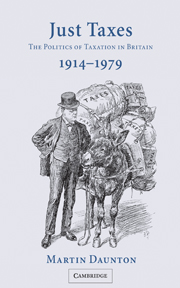Book contents
- Frontmatter
- Contents
- List of figures
- List of tables
- Preface
- List of abbreviations
- 1 The taxing state: an introduction
- 2 ‘The limits of our taxable capacity’: war finance, 1914–1918
- 3 ‘This hideous war memorial’: debt and taxation, 1918–1925
- 4 ‘Adjusting the particular turns of the different screws’: reforming the income tax, 1920–1929
- 5 ‘The great conflict of modern politics’: redistribution, depression and appeasement, 1929–1939
- 6 ‘The exigency of war’: taxation and the Second World War, 1939–1945
- 7 ‘The mortal blows of taxation’: Labour and reconstruction, 1945–1951
- 8 ‘A most injurious disincentive in our economic system’: Conservatives and taxation, 1951–1964
- 9 ‘Modern and dynamic economic policy’: Labour and taxation, 1951–1970
- 10 Rethinking taxation policy: from an opportunity state to an enterprise society, 1964–1979
- 11 ‘Highly defensible ramparts’: the politics of local taxation
- 12 Conclusion
- Appendix: chancellors of the Exchequer and prime ministers, 1908–1983
- Bibliography
- Index
1 - The taxing state: an introduction
Published online by Cambridge University Press: 23 December 2009
- Frontmatter
- Contents
- List of figures
- List of tables
- Preface
- List of abbreviations
- 1 The taxing state: an introduction
- 2 ‘The limits of our taxable capacity’: war finance, 1914–1918
- 3 ‘This hideous war memorial’: debt and taxation, 1918–1925
- 4 ‘Adjusting the particular turns of the different screws’: reforming the income tax, 1920–1929
- 5 ‘The great conflict of modern politics’: redistribution, depression and appeasement, 1929–1939
- 6 ‘The exigency of war’: taxation and the Second World War, 1939–1945
- 7 ‘The mortal blows of taxation’: Labour and reconstruction, 1945–1951
- 8 ‘A most injurious disincentive in our economic system’: Conservatives and taxation, 1951–1964
- 9 ‘Modern and dynamic economic policy’: Labour and taxation, 1951–1970
- 10 Rethinking taxation policy: from an opportunity state to an enterprise society, 1964–1979
- 11 ‘Highly defensible ramparts’: the politics of local taxation
- 12 Conclusion
- Appendix: chancellors of the Exchequer and prime ministers, 1908–1983
- Bibliography
- Index
Summary
One of the clearest contrasts between Conservative and Socialist policy is in the field of taxation. Conservatives believe that high taxation discourages enterprise and initiative, and so tends to impoverish the whole nation … By contrast, Socialist policy contains little mention of tax reduction and indeed most Socialists welcome high taxation as a means of achieving their aim of universal equality.
Conservative party, The Campaign Guide 1959: The Unique Political Reference Book (London, 1959), p. 19In 1979, the Conservatives returned to power and Margaret Thatcher became prime minister. Their success in the general election has many explanations, but one important theme was the widespread sentiment that taxes were too high and the public sector too large and unaccountable. The Thatcher government embarked on a campaign to roll back the state, through privatisation and the sale of council houses; it achieved less success in reducing the overall level of fiscal extraction in order to encourage enterprise and initiative. Taxes were 45.9 per cent of gross domestic product (GDP) in 1979, rising to 49.9 per cent in 1984; the figure dropped to 41.4 per cent in 1989, but returned to 46.8 per cent in 1993 (see table 1.1 and figure 1.1). Despite the difficulties in reducing taxation as a whole, the structure of taxation was changed in pursuit of Mrs Thatcher's vision of a dynamic society based on enterprise and incentives.
- Type
- Chapter
- Information
- Just TaxesThe Politics of Taxation in Britain, 1914–1979, pp. 1 - 35Publisher: Cambridge University PressPrint publication year: 2002



